
What should you do if your small open boat capsizes? A comprehensive guide

Boating is an exhilarating activity that offers a unique way to connect with nature. Whether you’re fishing, enjoying a day out with the family, or exploring remote waters, the experience can be both relaxing and adventurous. However, one of the inherent dangers of boating, especially in small open boats, is the possibility of capsizing. Knowing what to do if your small open boat capsizes can be the difference between life and death. This article will go over in detail the steps you should take to ensure the safety of yourself and others on board.
Understanding why boats capsize
Before figuring out what steps you should take after a capsize, it’s important to understand why boats capsize. A small open boat is particularly vulnerable due to its size and design, which makes it more susceptible to external factors such as
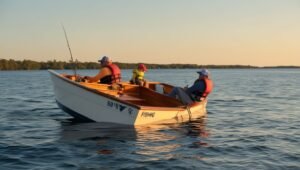 Overloading Exceeding the boat’s weight capacity with passengers, gear, or both can cause instability.
Overloading Exceeding the boat’s weight capacity with passengers, gear, or both can cause instability.
Uneven weight distribution: Placing too much weight on one side of the boat can cause it to slide.
Weather conditions Sudden changes in weather, including strong winds and large waves, can cause a small boat to capsize.
Improper Handling Sharp turns, sudden stops, or failure to properly navigate waves can lead to capsizing.
Swamp Taking on water due to high tides, rain, or leaks can cause a boat to lose buoyancy and capsize.
Understanding these risks is the first step in preventing capping, but even with the best precautions, accidents can still happen.
Immediate actions after Capsizing
If your small open boat capsizes, it’s important to stay calm and act quickly. Here’s a step-by-step guide to help you manage the situation
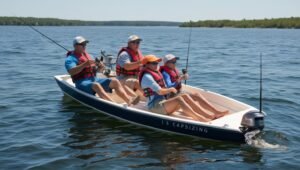
Assess the situation.
Stay calm Nervousness can lead to poor decision-making. Take a deep breath and assess your surroundings.
Check for injuries: Make sure you and your passengers are not injured. If someone is hurt, prioritize first aid after safety is established.
Stay with the boat
Don’t swim away: One of the basic rules for surviving a drowning is to stay with the boat. A small boat, even if overturned, is easier to spot than a person swimming alone in open water.
Climb up If possible, climb onto the hull of an overturned boat. This not only keeps you out of the water, which can get cold and cause hypothermia but also makes you more visible to rescuers.
Signal for help
Use a whistle or horn If you have a signaling device, use it to attract attention.
Wave your arms: If you don’t have a signaling device, wave your arms to make yourself more visible.
Use a mirror If it’s sunny, a reflective object like a mirror can be used to signal for help.
Account for all passengers
Headcount Make sure everyone on the boat is accounted for. If one is missing, check under the boat or in the surrounding water.
Help others Help others stay calm and get to safety, either by holding onto the boat’s hull or sides.
Assess water conditions.
Temperature Check If the water is cold, hypothermia is a concern. In such cases, minimize movement to conserve body heat.
Currents and waves Be aware of water conditions. Strong currents or waves can push you away from the boat or make it difficult to hold onto.
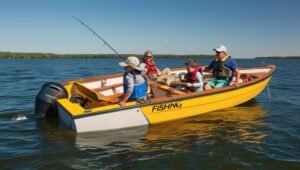
Attempt to right the boat (if possible)
Understand the design of your boat: Some small boats are designed to be easily righted after sinking. Check your boat’s manual beforehand to find out if and how this can be done.
Righting the boat: If it’s safe and possible, you and your passengers can try to right the boat by pushing down on one side and pulling on the other. This method works best with small boats such as canoes or kayaks.
If the boat cannot be righted
Stay Afloat: Use the boat as a flotation device. Even if it is overturned, it will likely still float.
Stay warm: If you’re in cold water, keep as much of your body out of the water as possible to reduce heat loss. Mixing with others can also help keep the heat in.
Wait for rescue.
Patience is key Rescue can take time, especially if you are in a remote area. Your priority is to stay calm, stick with the boat, and conserve energy.
Use available resources If you have flares, radios, or other signaling devices, use them to improve your chances of being found.
Preventive measures
While it’s important to know what to do if your boat capsizes, prevention is always better than cure. Here are some precautions you can take to reduce the risk of capping:
Check weather conditions before heading out.
Always check the weather forecast before going out. Avoid boating in bad weather conditions or when strong winds and waves are expected.
Do not overload your boat.
Stick to your boat’s weight capacity. Overloading with passengers or cargo increases the risk of capping. Make sure the weight is evenly distributed throughout the boat.
Wear life jackets.
Make sure everyone on board wears a life jacket at all times. Life jackets are very important to prevent drowning, especially in the event of a drowning.
Practice boat handling.
Familiarize yourself with how your boat handles different conditions. Practice maneuvers such as sharp turns, stops, and navigating through waves.
Know your boat’s capabilities.
Understand your boat’s limitations, including its stability and how it reacts to different loads and conditions. If your boat is small and open, avoid areas with big waves or strong currents.
Regular maintenance
Keep your boat in good condition. Check for leaks, make sure the bilge pump is working, and maintain the engine if you have one. A well-maintained boat is less likely to experience problems that could lead to sinking.
Emergency kit
Always carry an emergency kit such as a whistle, flares, first aid kit, and a waterproof flashlight. These items can be invaluable if turned over.
Sailing courses
Taking a boating safety course can give you the knowledge and skills to deal with emergencies, including capsizing. Many courses also cover first aid, which can be important in an emergency.
Hypothermia: A Silent Danger
One of the biggest risks after capping, especially in cold water, is hypothermia. Hypothermia occurs when the body loses heat faster than it should, causing a dangerous drop in body temperature.
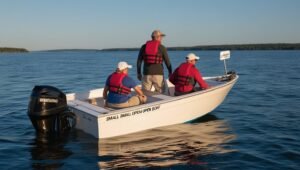
Symptoms of hypothermia
Trembling
slurred speech
Confusion or memory loss
Fatigue or drowsiness
Lack of awareness
Prevention of hypothermia:
Dress appropriately Dress in layers, including a waterproof outer layer. Consider wearing a wetsuit or dry suit in cold water conditions.
Stay dry Once you’re out of the water, do your best to stay dry. If you have dry clothes available, remove wet clothes.
Huddle together If you are with others, huddle together to share body heat.
Limited movement Movement in cold water increases heat loss. Keep movement to a minimum to conserve energy and body heat.
When to abandon ship
In some rare cases, you may need to abandon the boat. This can happen if
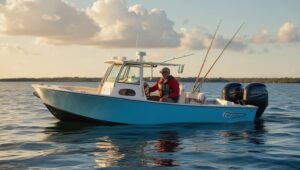
The boat is sinking fast.
The boat is caught in a strong current that is pulling it toward a hazard such as rocks or a waterfall.
The boat is sailing in more dangerous waters, such as a storm or an area with heavy boat traffic.
If you must abandon the boat:
Stay calm: Take a deep breath and plan an exit.
Use flotation devices: Grab a life jacket or other flotation device before leaving the boat.
Swimming with a purpose: to swim to shore or another safe place. If possible, stay close to others and move as a group.
